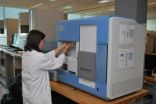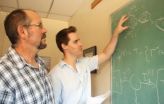(Press-News.org) Northwestern University researchers have taken another step towards realizing a new class of polymerase chain reaction (PCR) enzyme mimics, opening the door for the development of highly sensitive chemical detection systems that go beyond nucleic acid targets.
The blueprint for building synthetic structures to detect and signal the presence of targets such as small molecule medical analytes (signalers of disease or bodily malfunction, such as neurotransmitters) and environmental hazards, such as TNT, to name just a few, is inspired by biology and its allosteric enzymes. The method also could be useful in catalysis and the production of polymers, including plastics.
The work, which promises higher sensitivity than that of current detection tools, will be published Oct. 1 by the journal Science.
"PCR -- the backbone of the biodiagnostics industry -- is an enzyme that binds to a nucleic acid and changes shape, turning on a catalyst that makes copies of the nucleic acid for detection purposes," said Chad A. Mirkin, George B. Rathmann Professor of Chemistry in the Weinberg College of Arts and Sciences.
"What if you could do that for thousands of small molecules of interest?" he said. "We'd like to be able to detect tiny amounts of targets important to medicine and the environment, opening avenues to new types of diagnostic tools, just as PCR did for the modern fields of medical diagnostics and forensics. Our new catalysts could make that possible."
Mirkin led a team of chemists who built a synthetic structure that, much like the layers of an Oreo cookie, sandwiches the catalyst between two chemically inert layers. This triple-layer architecture allows the use of any catalyst as it will be kept inactive, or in an "off" state, until triggered by a specific small molecule.
The enzyme mimic behaves like allosteric enzymes found in nature, catalysts that change shape to carry out their functions. (Hemoglobin is an example of an allosteric enzyme.) When the mimic reacts with a specific small molecule, the triple-layer structure changes shape and opens, exposing the catalyst. The resulting catalytic reaction signals the presence of the small molecule target, much like PCR amplifies a single piece of DNA.
"One of our challenges as synthetic chemists has been learning to synthesize structures inspired by biology but that have nothing to do with biology other than the fact we'd like such complex functions realized in man-made systems," said Mirkin, also director of Northwestern's International Institute for Nanotechnology.
In the work reported in Science, the researchers use an aluminum salen complex as the catalyst in the three-layer structure. The addition of chloride (the reduced form of chlorine) triggers the catalyst and starts the polymerization process. (Chloride ion binds at an allosteric binding site, distant from the active or catalytic site.) The addition of an agent that removes the chloride stops the process, but the chloride can be added back to start it again.
INFORMATION:
The title of the paper is "Allosteric Supramolecular Triple-Layer Catalysts." In addition to Mirkin, other authors of the paper are Hyo Jae Yoon, Junpei Kuwabara and Jun-Hyun Kim, all from Northwestern.
Catalyst sandwich
Synthetic PCR mimic could lead to highly sensitive medical, environmental diagnostics
2010-10-01
ELSE PRESS RELEASES FROM THIS DATE:
Testing African couples for HIV is cost-effective prevention strategy
2010-10-01
As researchers and policymakers work toward an effective HIV vaccine in a constrained global economy, cost-effective prevention strategies such as Couples Voluntary Counseling and Testing (CVCT) must take a larger role in efforts to decrease the rates of HIV/AIDS in Africa, says Emory University HIV/AIDS vaccine researcher Susan Allen, MD, MPH.
Allen, who has worked to combat the AIDS epidemic in Africa for more than 25 years, highlighted the value of CVCT and other cost-effective HIV prevention strategies today at the AIDS Vaccine 2010 Conference in Atlanta.
"The ...
Chromosomal break gives scientists a break in finding new puberty gene
2010-10-01
A break in the two chromosomes has given scientists a break in finding a new gene involved in puberty, Medical College of Georgia researchers report.
It's also helped clear up why some patients with delayed puberty have no sense of smell, said Dr. Lawrence C. Layman, chief of the MCG Section of Reproductive Endocrinology, Infertility and Genetics.
The WRD11 gene interacts with a transcription factor that appears to be involved in development of gonadotropin releasing hormones that enable sexual maturation as well as olfactory neurons in the brain, according to a study ...
Bedouin tribe reveals secrets to McGill's GA-JOE
2010-10-01
Van Den Ende-Gupta syndrome (VDEGS) is an extremely rare genetic disorder that is characterized by distinctive head and facial features, such as unusual eyelids, narrow and beaked noses, flat nasal bridges, jaw deformities, and a turned out lower lip. As part of McGill's "RaDiCAL" project (Rare Disease Consortium for Autosomal Loci), collaborators in Qatar conducted field research with three patients from biologically interrelated Bedouin families, and sent samples to Canada for analysis by GA JOE – a high-tech genome analyzing machine. The research effort was led by husband ...
Key leukemia defense mechanism discovered by VCU Massey Cancer Center
2010-10-01
Richmond, Va. (September 30, 2010) – Virginia Commonwealth University Massey Cancer Center researcher Steven Grant, M.D., and a team of VCU Massey researchers have uncovered the mechanism by which leukemia cells trigger a protective response when exposed to a class of cancer-killing agents known as histone deacetylase inhibitors (HDACIs). The findings, published in the Journal of Biological Chemistry, could lead to more effective treatments in patients with leukemia and other cancers of the blood.
"Our findings provide new insights into the ways such cancer cells develop ...
'Great strides' in treatment of stroke, headache, epilepsy
2010-10-01
MAYWOOD, Il. -- The latest advances in treating neurologic disorders such as stroke, headache, Parkinson's disease, epilepsy and sleep disorders are detailed in a special issue of the journal Neurologic Clinics.
Guest editor is Dr. Jose Biller, chairman of the Department of Neurology at Loyola University Chicago Stritch School of Medicine.
"Great therapeutic strides in the clinical neurosciences have been made in the past decades," Biller wrote in the preface to the November 2010 issue, now available online. "It is likely that subsequent decades will bring even greater ...
OHSU Toxicology Research Center issues public alert on popular hair salon treatment
2010-10-01
PORTLAND, Ore. — Oregon Health & Science University's Center for Research on Occupational and Environmental Toxicology (CROET) is responding to concerns raised by Portland-area hair salons about a product used for hair straightening. CROET has issued two public alerts describing its findings on the possible negative health impacts of this product.
The product being tested is called Brazilian Blowout. After receiving two samples from Portland-area salons, CROET asked the Department of Consumer and Business Services' Oregon Occupational Safety & Health Division to chemically ...
October 2010 Geology and GSA Today highlights
2010-10-01
Boulder, CO, USA – The October Geology includes a study using fish teeth to understand ocean circulation; discussion of the "Dead Clade Walking" taxa; description of the first reported example of igneous aragonite; discovery of a Paleogene California River, flowing in similar location but opposite direction to the Colorado River; a report of the earliest definite record of predation on pelagic sea lilies; and discovery of the only known active drumlin field in the world. GSA Today examines calderas.
Relationship between mass extinction and iridium across the Cretaceous-Paleogene ...
Turning waste heat into power
2010-10-01
What do a car engine, a power plant, a factory and a solar panel have in common? They all generate heat – a lot of which is wasted.
University of Arizona physicists have discovered a new way of harvesting waste heat and turning it into electrical power.
Using a theoretical model of a so-called molecular thermoelectric device, the technology holds great promise for making cars, power plants, factories and solar panels more efficient, to name a few possible applications. In addition, more efficient thermoelectric materials would make ozone-depleting chlorofluorocarbons, ...
New report on street lighting technologies available from NLPIP at Rensselaer Polytechnic Institute
2010-10-01
Troy, N.Y. – The National Lighting Product Information Program (NLPIP) released its latest Specifier Report, designed to provide objective performance information on existing street lighting technologies -- including light-emitting diode (LED), induction, and high pressure sodium (HPS) streetlights. This report comes at a critical time when many municipalities, some with funding from the American Recovery and Reinvestment Act of 2009, are in the process of replacing HPS streetlights with LED and induction models.
NLPIP, established by Rensselaer Polytechnic Institute's ...
Newly discovered planet may have water on its surface
2010-10-01
A team of astronomers that includes the University of Hawaiʻi' at Manoa's Nader Haghighipour has announced the discovery of a planet that could have liquid water on its surface.
The planet, which is probably 30 percent larger than Earth, was discovered using one of the telescopes of the W. M. Keck Observatory on Mauna Kea. It orbits a relatively small star, Gliese 581, that is 20 light-years from Earth in the constellation Libra.
"By determining the orbit of this planet, we can deduce that its surface temperature is similar to that of Earth," said Haghighipour. ...
LAST 30 PRESS RELEASES:
New fully digital design paves the way for scalable probabilistic computing
Membrane electrode assembly design for high-efficiency anion exchange membrane water electrolysis
U.S. debt ceiling disputes show measurable impact on global crude oil markets
Climate extremes triggered rare coral disease and mass mortality on the Great Barrier Reef
Direct observation reveals “two-in-one” roles of plasma turbulence
Humans rank between meerkats and beavers in monogamy ‘league table’
US fossil reveals early mass-burial event and ancient microbial attack
Sedative choice could improve outcomes for breathing tube patients
New superconducting thin film for quantum computer chips
Simulations reveal protein "dynamin" constricts cell membranes by loosening its grip
Nearly 1 in 5 UK emergency department patients cared for in corridors/waiting rooms
Heavy energy drink intake may pose serious stroke risk, doctors warn
Violence against women and children among top health threats: New global study reveals disease burden far larger than previously estimated
Predicting who is at risk of developing type 1 diabetes, as new drugs now available
New gene-mapping method unlocks hidden drivers of cancer
Ocean current and seabed shape influence warm water circulation under ice shelves
Call to increase funding for ‘invisible’ Deaf victim-survivors of domestic abuse
University of Maryland School of Medicine names distinguished scientist and academic leader Gerald M. Wilson, PhD, as Chair of the Department of Biochemistry and Molecular Biology
Receptors in mammary glands make livestock and humans inviting hosts for avian flu
Icy hot plasmas
Treating adults with autism: Maryland Clinical Center offers national blueprint for care after pediatric transition
University of Phoenix College of Doctoral Studies releases white paper on reclaiming control to build workforce resilience
NCCN Summit seeks to improve care for veterans and first responders with cancer from line-of-duty exposure
ERC Consolidator Grant for soft robotics researcher
Dual-action arts and wellbeing program transforms dementia care
The global plastic waste trade contributes to coastal litter in importing countries, study shows
UT Dallas partners with Tech Mahindra on AI innovation
Blinking less could signal the brain is working harder to listen, Concordia study shows
Male bonobos track females’ reproductive cycle to maximize mating success
New report outlines science priorities for human Mars exploration
[Press-News.org] Catalyst sandwichSynthetic PCR mimic could lead to highly sensitive medical, environmental diagnostics


